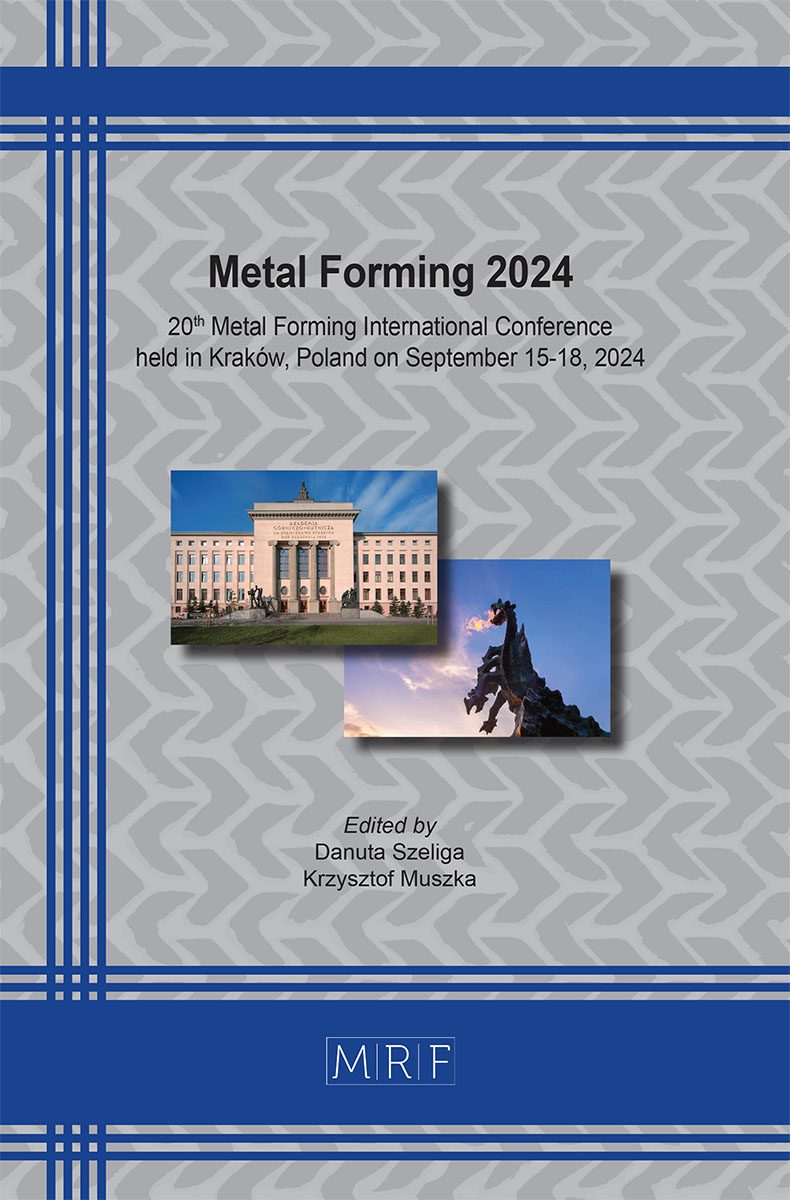–
Influence of hardening model on draw-bending springback prediction of DP980 dual-phase steel
ZHENG Xuebin, HAN Longshuai, Hongwei E, LIU Yu, LI Xuetao, WU Xiangdong, WAN Min
download PDFAbstract. Springback is a key factor affecting the dimensional and shape accuracy of cold-formed high-strength steel parts, and the accuracy of high-strength steel springback prediction depends on the accurate material constitutive model. Therefore, it is important to study the influence of the constitutive model on springback prediction accuracy. In this paper, the parameters of the Yoshida-Uemori (Y-U) dynamic hardening model of DP980 dual-phase steel were determined through tension-compression tests with two different strain levels and multicycle tension-compression tests. Based on the draw-bending test platform, the influence of roll radius and normalized back force on the springback of DP980 was investigated. Additionally, the effect of different hardening models (Swift model, Y-U model) on the prediction of draw-bending springback was studied by using Abaqus finite element analysis software. The results show that increasing the bending radius and normalized back force can reduce the springback angle and side wall crimp. The tension-compression testing strategy shows little effect on the calibrated Y-U model parameters of DP980 dual-phase steel. The Y-U model can achieve better prediction accuracy for draw-bending springback angle and curvature compared to the Swift isotropic hardening model.
Keywords
DP980 Dual-Phase Steel, Y-U Model, Draw-Bending, Elastic Modulus, Springback Prediction
Published online 9/15/2024, 9 pages
Copyright © 2024 by the author(s)
Published under license by Materials Research Forum LLC., Millersville PA, USA
Citation: ZHENG Xuebin, HAN Longshuai, Hongwei E, LIU Yu, LI Xuetao, WU Xiangdong, WAN Min, Influence of hardening model on draw-bending springback prediction of DP980 dual-phase steel, Materials Research Proceedings, Vol. 44, pp 580-588, 2024
DOI: https://doi.org/10.21741/9781644903254-62
The article was published as article 62 of the book Metal Forming 2024
![]() Content from this work may be used under the terms of the Creative Commons Attribution 3.0 license. Any further distribution of this work must maintain attribution to the author(s) and the title of the work, journal citation and DOI.
Content from this work may be used under the terms of the Creative Commons Attribution 3.0 license. Any further distribution of this work must maintain attribution to the author(s) and the title of the work, journal citation and DOI.
References
[1] S. Li, Y. Zhang, L. Qi, et al., Effect of single tensile overload on fatigue crack growth behavior in DP780 dual phase steel, Int. J. Fatigue 106 (2018) 49-55. https://doi.org/10.1016/j.ijfatigue.2017.09.018
[2] D.-K. Kim, E.-Y. Kim, J. Han, et al., Effect of microstructural factors on void formation by ferrite/martensite interface decohesion in DP980 steel under uniaxial tension, Int. J. Plast. 94 (2017) 3-23. https://doi.org/10.1016/j.ijplas.2017.04.019
[3] A.S. Khan, M. Baig, S.-H. Choi, et al., Quasi-static and dynamic responses of advanced high strength steels: Experiments and modeling, Int. J. Plast. 30-31 (2012) 1-17. https://doi.org/10.1016/j.ijplas.2011.08.004
[4] J.-Y. Lee, F. Barlat, M.-G. Lee, Constitutive and friction modeling for accurate springback analysis of advanced high strength steel sheets, Int. J. Plast. 71 (2015) 113-135. https://doi.org/10.1016/j.ijplas.2015.04.005
[5] Wang Jianfeng, Principles of the draw-bend springback test, The Ohio State University, Columbus, 2004.
[6] X. Li, H. Dong, C. Yu, H. Wang, Z. Zang, B. Song, Y. Wang, D. Li, Influence of yield criteria and hardening model on draw-bending springback prediction of DP780, J. Mech. Eng. 45 (2020) 110-115. https://doi:10.3901/JME.2020.12.042
[7] Carden W D, Geng L M,Matlock D K, et al., Measurement of Springback, International Journal of Mechanical Sciences, 44 (2002) 79-101. https://doi.org/10.1016/S0020-7403 (01)00082-0
[8] Wang Jianfeng, Wagoner R H, Matlock D K., Anticlastic curvature in draw bend springback, International Journal of Solids and Structures, 42 (2005) 1287-1307. https://doi.org/10.1016/ j.ijsolstr.2004.08.017
[9] Hocine Chalal, Sever-Gabriel Racz, Tudor Balan., Springback of thick sheet AHSS subject to bending under tension, International Journal of Mechanical Sciences, 59 (2012) 104-114. https://doi.org/10.1016/j.ijmecsci.2012.03.011
[10] Song Bingyi, Meng Bao, Wan Min. Research progress of cyclic plastic hardening model and experiment for metal Sheetss, Journal of netshape forming engineering, 11 (2019) 28-41. https://doi.org/10.3969/j.issn.1674-6457.2019.03.003.
[11] Yoshida F,Uemori T., A model of large-strain cyclic plasticity describing the Bauschinger effect and workhardening stagnation, International Journal of Plasticity, 18 (2002) 661-686. https://doi.org/10.1016/S0749-6419(01)00050-X
[12] Yoshida F,Uemori T., A model of large-strain cyclic plasticity and its application to springback simulation, International Journal of Mechanical Sciences, 45 (2003) 1687-1702. https://doi.org/10.1016/j.ijmecsci.2003.10.013
[13] Lin Jianping, Hou Yong, Min Junying, et al., Effect of constitutive model on springback prediction of MP980 and AA6022-T4, International Journal of Material Forming, 13 (2020) 1-13. https://doi.org/10.1007/s12289-018-01468-x.
[14] Min Junying, Guo Nan, Hou Yong, et al., Effect of tension-compression testing strategy on kinematic model calibration and springback simulation of advanced high strength steels, International Journal of Material Forming, 14 (2021) 435-448. https://doi.org/10.1007/ s12289-020-01583-8
[15] Barlat F, Gracio J, Lee M G, et al., An alternative to kinematic hardening in classical plasticity, International Journal of Plasticity, 27 (2011) 1309-1327. https://doi.org/10.1016/ j.ijplas.2011.03.003
[16] Lee J Y, Lee J W, Lee M G, et al., An application of homogeneous anisotropic hardening to springback prediction in pre-strained U-draw/bending, International Journal of Solids and Structures, 49 (2012) 3562-3572. https://doi.org/10.1016/j.ijsolstr.2012.03.042
[17] Chaboche J L., Constitutive equations for cyclic palsticity and cyclic viscoplasticity, International Journal of Plasticity. 5 (1989) 247-302. https://doi.org/10.1016/0749-6419 (89)90015-6












